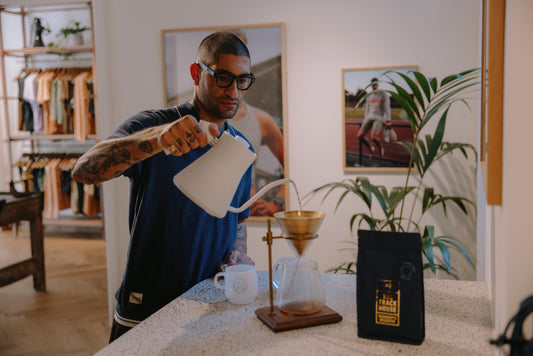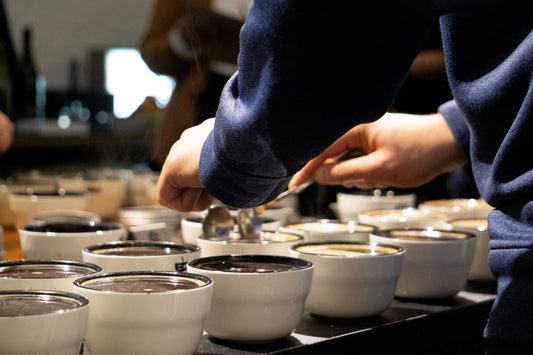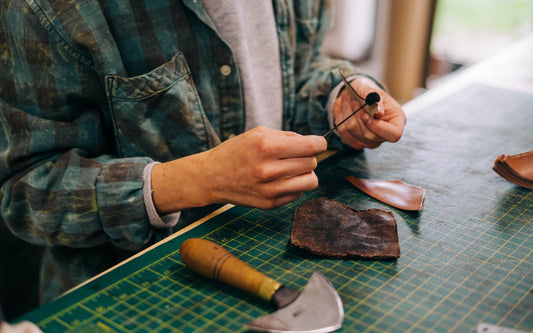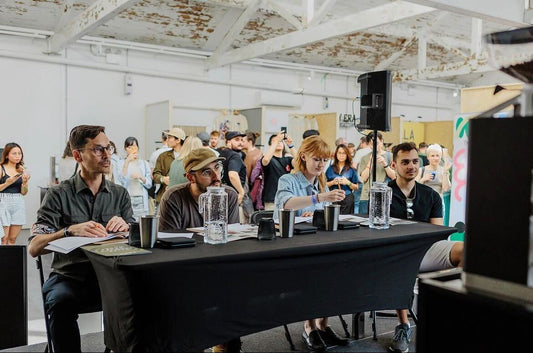The last six months have been an absolute whirlwind.
Moving the production department into a purpose built space in Bethnal Green has seen much more than just an address change. We’ve installed and commissioned a brand new P25 Probat roaster with their much improved burner technology and implemented a whole host of new quality control equipment: a Sinar BeanPro moisture meter, a ColorTrack colour analyser, an Ikawa sample roaster and a temperature controlled green coffee room fitted with a UV light to help us better identify and sort defects.



Getting to grips with the new roaster and profile of our coffees has been a huge learning experience. Previously, roasting on the P12 Probat in our Clerkenwell Cafe, we were turning 8 kilo batches for filter roasts to ensure adequate development and to drop them in our desired timeframe. Meanwhile, the maximum batch size we could roast for espresso while still thoroughly enjoying the results was 11 kilos.
When familiarising ourselves with the new roaster and attempting to profile our coffees, it felt like we’d traded in our old, reliable Volvo for a turbo-charged Porsche; we needed to learn how to drive again given the incredible amount of acceleration and braking at our disposal. The sheer power from the new burner dictated we revise and establish very different in-between batch protocols compared to the former P12, whilst starting gas percentages, and charge temperatures in particular, changed quite dramatically to ensure we created roast recipes that produced properly developed roasts and thus delicious cups of coffee. 
We never expected to put 25 kilos into the beast. Instead we started with trial batches of a very conservative 16 kilos. Having to really slam the brakes on to avoid roasts reaching their ideal drop temperatures in 9 minutes or less led us to incrementally up the batch size. Trialling 18 and 20 kilos offered greater control, but again these sizes had a tendency to fly through the roasting process if not monitored carefully. After numerous stages of trial and error, 22 kilo batches brought us to a position where we had the ability to manipulate and control the batch with delicacy, but without the feeling equivalent to aquaplaning that we felt with the smaller batches.
Given increased power, and greater control via the new touchpad interface, we felt confident turning batches of filter and espresso roasts with the same green weight. An added benefit of keeping the batch size the same for both styles of roasting is in making it easier to compare and contrast the two styles of roasting (not to mention more thermal stability and predictability between batches).

With greater ease, we’re better able to compare the approach to roasting a filter and an espresso batch and subsequently pin down exactly where we can achieve the following for an espresso:
- Increased solubility
- Mellower acidity
- Increased body
As unfashionable as it is to say, our espresso roasts won’t create an optimally agreeable cup when brewed to 1.3-1.5% TDS. However, in a vastly greater concentration of 8-10% TDS, the traits we aim for with our espresso roasts do go a long way to improving the balance of the cup.
Espresso is brewed with much less water, the solvent to dissolve flavour, as well as being vastly less clarified than paper-filtered, brewed coffee. This concentration of goodies dissolved in the cup (along with the oft-forgotten undissolved solids - suspended oils, lipids and particulates that worm their way through holes in your VST basket, some getting emulsified along the way) creates a uniquely textured beverage. We still want to strike a balance between sweetness, acidity and bitterness, all with a clarity of flavour, and, thanks to a lot of experimenting in our dedicated espresso QC lab, we've been able to amend our house espresso recipes.
Recently dropping our basket size down and altering the dose of coffee accordingly has allowed us to reduce the machine temperature, making for more uniform and stable brewing conditions within the portafilter basket. This, coupled with a slightly reduced pump pressure and fractionally more open brew ratio, has led to espresso shots with superb sweetness, great clarity and a much more velvety mouthfeel.
A caveat: when designing your espresso recipe and brewing specs you first need to understand what drinks you will be serving and how many of them you need to brew in a given amount of time. A very different brew recipe would be required for a cafe serving 1,000 12oz lattes a day versus a curated coffee service serving exclusively espresso at a low volume event.
Previous Specs:
Mazzer Robur
17g LM Basket / 18g VST Basket
18.0g coffee
36-38g espresso
33-35s extraction
9 bar pressure
94.0C water (at ~100ppm)
New Specs:
Mazzer Robur / Mythos Clima-Pro
15g VST Basket
16.0g coffee
33g espresso
30-32s extraction
7.5 bar pressure
92.0C water (at ~100ppm)


With a greater understanding of the green coffee entering the building and more control over it before it gets near the roaster, as well as a multitude of new ways to predict, control and adapt our roasting approach, we are happier than ever with the results.
Six months on in Bethnal Green and we’ve come a long way, but there’s still so much more to be done.
Share:






